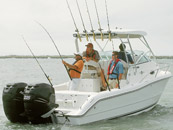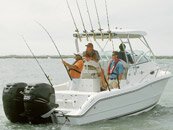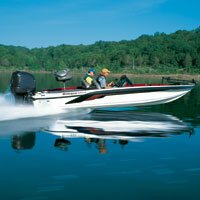
If you want to catch enough fish in the Upper Gulf for a fish fry this year, you’ll have to fish for the aggregate, made up of a total of 20 different species, each with its own size and bag-limit restrictions. You can have five grouper, but only two red grouper; two American red snapper at least 16 inches long; one amberjack, ten mangrove snapper; plus triggerfish, vermilion snapper and other species. Ironically enough, the trick becomes not only successfully targeting fish, but avoiding fish. How do you, for example, catch triggerfish and not catch the abundant red snapper, or catch amberjack when king mackerel won’t stay off your baits? It’s not easy. To learn how to catch the aggregate effectively, we talked to Captain Butch Tucker of Orange Beach, AL, a 38-year veteran of fishing the Gulf of Mexico.
“I’ve fished from Louisiana to Panama City, Florida, throughout my career, and for the last 18 years, I’ve fished out of Orange Beach, AL,” Tucker says. “Before I got my captain’s license, I was a commercial fisherman. In total, I’ve fished the Gulf of Mexico for 44 years.”
Until about 20 years ago, saltwater fish in the Gulf of Mexico had no seasons, size or bag limits. “Initially, these catch limits were a good idea,” Tucker mentions. “But recently, red snapper have become so over-protected that they’re now preying on triggerfish and other reef fish. The red snapper’s becoming a detriment to other species in the Upper Gulf Coast waters.” Today, instead of trying to catch red snapper, most saltwater fishermen have to search for ways not to catch them.
Preparation Counts
“If you’ll be catching the aggregate, start by catching live bait like blue runners, pinfish, croakers and others that you can feed to the bigger fish,” Tucker suggests. “If you can’t catch live bait, you may be able to purchase it.”
Regardless of the species he’s targeting first, Tucker puts out “feather dusters” and trolls on the way to his fishing grounds. “Most fishermen use 60-pound-test wire line for high-speed trolling, to allow their baits to get deeper than monofilament line will,” Tucker emphasizes.
Many anglers prefer basic trolling lures for fast trolling, but others lean toward other lures designed to track right at trolling speeds upwards of 12 knots. Fifteen to 20 feet in front of the lure, most anglers run a one- to a 1-1/2-pound lead to help get the line and the lure deeper in the water. The boats troll these lures at 15 knots or less in hopes of catching king mackerel, bonito, wahoo or possibly blackfin tuna. You can keep two king mackerel, which generally range from 8 to 50 pounds, per person. If you catch two or three wahoo, consider it a great fishing day.
“Because we have live bait, my second target species will be amberjack,” Tucker explains. “Amberjack tend to hold on large wrecks, offshore rocks and reefs and deep-water gas and oil platforms—basically any large man-made or natural structures that can support plenty of baitfish.”
You can catch amberjack in water as shallow as 60 feet deep to depths of 400 feet, but generally in the mid or upper stories of the water column. “We use 60- to 80-pound main line and put a 6- to 8-ounce slip lead up the line,” Tucker explains. “Below the sinker, we’ll tie in a barrel swivel and 6 to 12 feet of leader.”
Amberjack can be finicky feeders. If they’re aggressive, though, you’ll only need a 6-foot leader. If resident AJs have experienced intense fishing pressure, you’ll drastically increase your chances of catching them by using a 12-foot leader. If you have small live baits, like pinfish or croakers, you may want to use a 5/0 hook. But, if you’re fishing with larger baits, like blue runners or vermilion snapper, you may want to go bigger—an 8/0 or 9/0. The size of the bait and the size of the amberjack you’re targeting usually will dictate the size of the hook you’ll need to use.
“We let our lines down gradually until we feel the amberjack take the bait,” Tucker notes. “Then we set the hook and start reeling. Remember that amberjack generally hold well off the bottom, from 30 feet up to within a foot or two of the surface.”
Today you can catch one amberjack per person in the aggregate. However, this regulation may change, so check the limits before you head out. Once Tucker has caught amberjack, he’ll search for red snapper.
Locating Quick and Easy Snapper
“We can fish one artificial reef or rock pile and limit out on red snapper,” Tucker says confidently. “Since the limit is only two snapper per person, and there are more red snapper on the Upper Gulf Coast now than ever before, catching the two-snapper limit is a quick and easy task.”
If you’re fishing for 2- to 4-pound snapper, use a two-hook rig and cut bait like squid, northern mackerel, cigar fish or bonito. But if you’re targeting big red snapper, you have two options.
“If we’re fishing in relatively shallow water, 130 feet or less, we’ll use a knocker rig fished on a light-action deck rod or a heavy-action spinning rod with 30- to 50-pound line,” Tucker says. “We’ll use a 2-ounce slip lead up the line and tie a 5/0 hook to the end of the knocker rig. This way, when the bait is cast out, the lead slides down the line ahead of the bait. By the time the lead reaches the bottom, it often separates itself from the hook, leaving 12 to 15 feet of free line between the lead laying on the bottom and the bait on the hook. By having this much separation, the bait generally can fall or swim to the bottom in a much more natural action than if the lead is closer to the bait. The knocker is especially effective when you’re fishing for big snapper in shallow water.”
Really big snapper concentrate in depths of 200 feet or more. In this deeper water, Tucker recommends fishing a sow rig on 60- to 80-pound test line. You’ll generally have an 8-ounce slip sinker up the line, a barrel swivel below the sinker and 5 to 12 feet of 50-pound-test mono coming off the bottom end of the barrel swivel with a 5/0 to 8/0 hook on the business end.
When fishing the sow rig, you’ll still use the big baits you’ve put on the knocker rig, but the sow rig lets your bait reach bottom quicker and stay there better than the lighter-weight knocker rig does. Since you only can catch and keep two red snapper, most anglers fish for the biggest they can find using these two rigs.
“Generally, after catching our red snapper limit, we’ll have amberjack and maybe one or two wahoo in the cooler as well, so it’s time to target the rest of the fish in the aggregate,” Tucker says.
Finishing the Aggregate Gets Tough
“Since we can only keep a total of 20 fish per person, we’ll target white, lane, vermilion and mangrove snapper, as well as scamp, grouper and triggerfish,” Tucker explains. “Getting a limit of five grouper with no more than two of them being reds—especially where I fish—is really difficult. This isn’t to say we won’t catch grouper, but if we’re trying to catch the aggregate, the grouper has to become an incidental catch. I’d rather spend the remainder of my time fishing where our chances are better for catching other species of snapper and triggerfish.”
Tucker says triggerfish usually hold in water less than 200 feet deep, particularly on natural structure in 90 to 130 feet. “I’ve found that live coral or rock bottoms tend to produce more white and vermilion snapper and triggerfish than wrecks, artificial reefs and oil or gas platforms do,” Tucker explains.
Initially, fishermen would set up where the continental shelf drops from 300 feet to more than 1,000 feet to try and stay away from the red snapper. However, because large numbers of Upper Gulf red snapper have moved out into deeper water, Tucker now sees shallow, live bottom as the best place to hide from red snapper while seeking the aggregate.
“I look for bottom structure that historically hasn’t held red snapper in order to fill out the aggregate,” Tucker says, but admits that finding such places has become increasingly difficult.
“For the past 38 years I’ve fished a spot on the west end of the Trysler Grounds, which is a live bottom southeast of Orange Beach,” Tucker says. “Although I’ve caught a few red snapper here, I’ve never caught a large number of them—usually I catch vermilions and whites. But in early May of 2008, I fished this spot with two-hook rigs, and the first time my customers let their lines down to the bottom, every one of them caught two red snapper.”
To take the other species of snapper and triggerfish, Tucker uses 60- to 80-pound-test line, to which he attaches a high-low rig with 2/0 to 3/0 hooks and a 12-ounce lead. “We use smaller cut bait, like squid, northern mackerel or cigar minnows,” Tucker explains. “If we’re lucky, and the red snapper don’t move into the area, we can finish out our aggregate with smaller reef fish and head home with plenty of fish in the box.”
Learning the Hard Cold Facts
In the Upper Gulf of Mexico from Louisiana to the Florida Panhandle, catching the aggregate has become more difficult as red snapper populations have exploded. The American red snapper appears to have displaced many of the other once-plentiful reef fish on reefs and wrecks. Although you’ll enjoy catching and releasing red snapper, you’ll have even more fun catching the aggregate and taking home fish to eat.
Content courtesy of Center Console Angler

